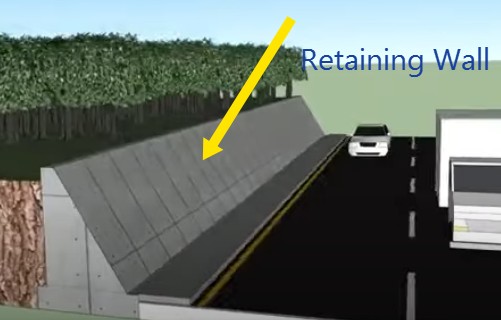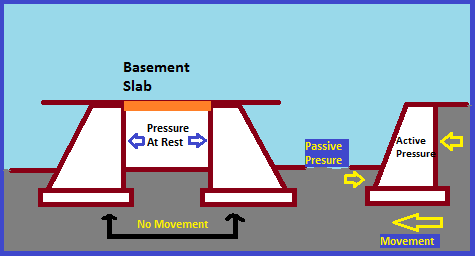What is Earth Pressure?
The pressure exerted by soil or earth on the retaining wall is known as Earth pressure. We provide a retaining wall to prevent soil from the sudden collapse of soil mass like a landslide.
A soil mass is stable when the slope of the surface of the soil mass is flatter than the safe slope.
At some locations where the space is limited, it is not possible to provide a flat slope and the soil is to be retained at a slope steeper than the safe one.
In such cases, a retaining structure is required for lateral support to the soil mass. The soil masses are either vertical or nearly vertical behind the retaining structure. Thus, a retaining wall maintains the soil at different elevations on either side.

The design of retaining wall structure requires the determination of the magnitude and line of action of the lateral earth pressure.
Different types of lateral earth pressure
Lateral earth pressure can be divided into three categories, depending upon the movement of the retaining wall with respect to the soil retained. The soil retained is also known as the backfill.

Active earth pressure
Active pressure occurs when the soil mass yields in such a way that it tends to stretch horizontally.
It is a state of plastic equilibrium as the entire soil mass is on verge of failure. A retaining wall when moves away from the backfill, there is a stretching of the soil mass & the active state of earth pressure exists.
In figure (b), the active pressure develops on the right hand side when the wall moves towards left.
Passive earth pressure
A state of passive earth pressure exists when the movement of the movement of the wall is such that the soil tends to compress horizontally.
It is another extreme of the limiting equilibrium condition. In figure (b), the passive pressure develops on the left side of the wall below the ground level, as the soil in this zone is compressed when the movement of the wall is towards left.
Earth pressure at rest
The lateral earth pressure is called earth pressure at rest when the soil mass is not subjected to any lateral yielding or movement.
This case occurs when the retaining wall is firmly fixed at its top and is not allowed to rotate or move laterally. In figure (a), shows the basement retaining walls which are restrained against the movement by the basement slab provided at their tops.
The earth pressure at rest condition is also known as the elastic equilibrium, as no part of soil mass has failed and attained the plastic equilibrium.
Read More,
Differences between compaction and consolidation process of Soil mass
Relation between Discharge velocity and Seepage velocity in soil mass
Numerical to calculate the plastic limit of soil |Plasticity index